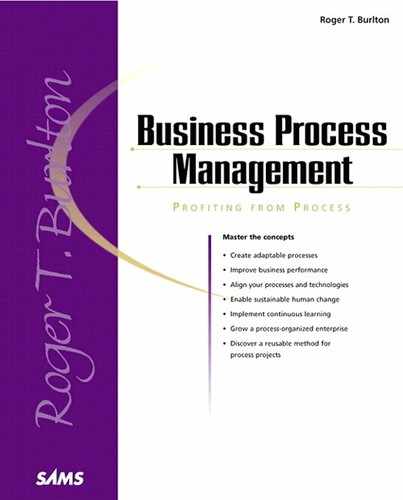Mapping Existing Process Understanding
This step obtains an understanding of how the existing process really is conducted and documents the understanding in a set of models and supporting notes. In this step, the project team validates and communicates the understanding to provide a baseline of understood process for gap analysis. It identifies process components to consider for measurement.
Figures 13.2 and 13.3 show examples of the knowledge produced as a result of this step.
Figure 13.2. The current process flow for the process of assigning human resources.

Techniques
During this step, models of the existing process are developed by using the following techniques:
- Interviewing
- Workshop facilitation
- IGOE or swim lane process modeling
Lessons Learned
While gathering process information, focus on process flow and the objects being transformed in the process. Start from the outcomes of the process and work backward. Doing so keeps the focus on the process’s purpose.
Decompose the process (step) into component subprocesses (a maximum of eight). Assign analysis responsibility to the team members to analyze components and interconnections, and to produce integrated flow and attribute models. Validate these models in a workshop.
Data models, and models or matrices of interaction between data and process, can be used. However, they won’t be as beneficial at this point as they will be later when new processes are being designed. They are optional here.
Conduct process interviews with workers. Manage the time for relevance because not all details are required. For example, don’t interview someone about everything she does in her job but instead discover what she does in her job that contributes to the process under study. In addition to interviewing the workers, talk to customers and suppliers. It’s hard to see the impact on them from the inside looking out.
Rather than try to analyze everything before reviewing it, use layered, timeboxed analysis and prioritization that schedules all sessions in advance and reviews what has been done to date. This learning style will develop buy-in and understanding as you go and will solve the problem of getting all the key stakeholders together on short notice. You can schedule them for all sessions in advance. Make sure that all understandings and analysis are validated. Never delay a feedback or validation session. Respect the interviewee’s time.
Prepare yourself to conduct interviews and run workshops. Practice before the real events, and allow sufficient time for each (two hours minimum). Document your interview results the same day you do them; otherwise, you will forget what happened. Use two staff members in information gathering interviews—one as interviewer and one as scribe. They can switch roles from session to session.
Ask these questions for each layer and process box:
What is produced (outputs), and to which process does it go?
What comes in (inputs), and from which process does it come?
What determines how the work will be performed (the guides), and from which process or external stakeholder does it come?
What is used repeatedly to do the work (enablers), and from which process or external stakeholder does it come?
Discover problems, suggestions for improvement, and opportunities for change by asking the people who do the work. They are your best source.
Don’t suggest fixes as you go. Save them for the early wins and prove the savings.
Ask questions regarding the organizational aspects, such as structure, as late as possible. If this is done too early, it can result in people feeling that they have to defend the process along organizational swim lane boundaries, rather than discover opportunities to improve across the entire process.
Don’t believe everything you hear. Observe the process by walking through it from beginning to end and pretending you are a customer for an order or a complaint. Walk through and challenge the troublesome situations you’ve heard about, not just the perfect flow.
As multiple versions and iterations of interviews are produced, an integrated process modeling software tool is invaluable for organizing the great amounts of information collected.

